by Tom Gaylord, a.k.a. B.B. Pelletier
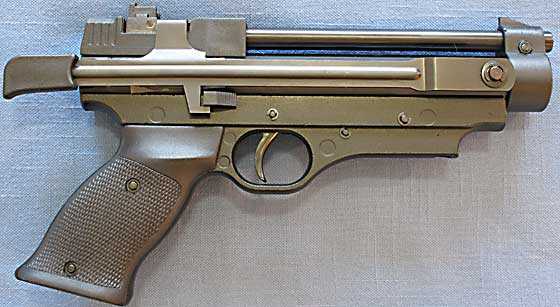
The Cometa Indian spring-powered air pistol is a powerful, big airgun.
Today, I’m testing the accuracy of the Cometa Indian air pistol. There’s been a lot of interest in this pistol, partly because it isn’t familiar to many of you — but mostly because of the power, the easy cocking and the value it represents.
I tested the pistol at 10 meters, using 10-meter pistol targets and a rested hold. For most of the shooting, my hands were forward of the bag, but I did do one experiment where I rested the pistol directly on the bag — and that I’ll address later.
This is a different air pistol
Before I start telling you about the results, I’d like to describe some things about this pistol that are different. For starters, the loading process is a bit fiddly, and I never quite got used to it. You have to put a pellet in the trough behind the breech, and I dropped more than a few of them during the 90-shot session. The rest of the cocking and loading process is learned very quickly.
The sights are different. The front sight is too tall for a 10-meter zero on a bullseye target — assuming a 6 o’clock hold that’s pretty standard. You’ll notice that all my shots are below the bull and there’s no elevation adjustment. I do like the image of the sharp front post against the rear notch, except for the top of the rear sight, which is angled up toward the center of the notch. That shape made it difficult to estimate where the top of the rear sight was when I shot, and I’m sure some of the openness of the groups was due to that. You’ll notice that they tend to be taller than they’re wide. If I owned this pistol, I would file the rear sight flat across the top and take the front post down a bit to bring the groups up.
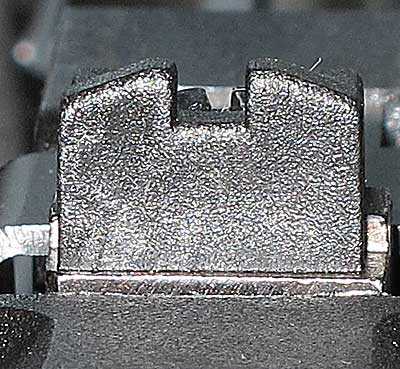
The tapered shape of the rear sight makes it very difficult to determine where the top is located when sighting. If this were my gun, I’d file it flat.
The trigger-pull does you no favors when shooting targets. The single-stage pull is too long and hard for the best results. I would so much prefer a crisp two-stage pull with a glass-rod release. That means the sear releases suddenly, like the breaking of a glass rod under pressure.
The pistol twists to the right when it fires. At first I thought it was just me, but then I watched it and the pistol is torquing at the moment of firing. I chalk that up to the centerline of the piston being so far above the web of your hand holding the grip. The Mars pistol (a semiautomatic firearm from the early 20th century) had the same problem, as did the broomhandle Mauser pistol.
I’m not saying that any of these aspects of the gun’s performance is a deal-breaker, but a buyer should know they are there. All air pistols have their little quirks. This was just the first time I’d noticed these.
Accuracy
I shot over 90 rounds with six different pellets in this test. I did so because the Indian was a new design to me, and I wanted to get to know it better. I’d tested the gun for The Airgun Letter years ago, but I don’t remember a thing from that test.
In the entire test, there was only one pellet that I would call bad in this pistol. Our friend the H&N Baracuda Green refused to shoot well for me, giving a 10-shot group that measures 2.46 inches between centers.
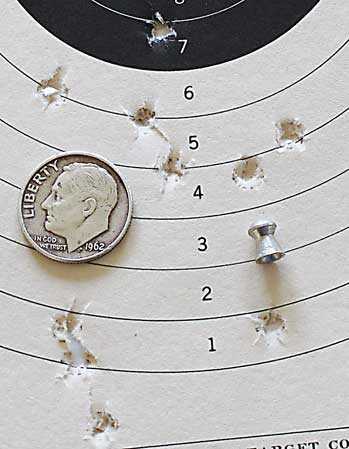
H&N Baracuda Greens were the worst pellet in the test. Ten shots in 2.46 inches between centers. Notice the group is more vertical than horizontal — supporting the rear-sight comment.
RWS R10 Match Pistol pellets and RWS Hobby pellets turned out a couple of so-so groups that were right around two inches. I can’t swear that I wouldn’t do better if I shot either of these two pellets again; but I was so interested in finding a good pellet, that I didn’t spend the time to find out. Please bear in mind that it only takes a couple sentences to describe a 10-shot group, but it can take over 10 minutes to actually shoot one!
Getting better
The H&N Baracuda Match was next. While there was a lone shot that opened the group to 2.021 inches, 9 of the shots landed in 1.343binches. I think the smaller group is more typical of the accuracy we can expect from this pellet in the Indian.
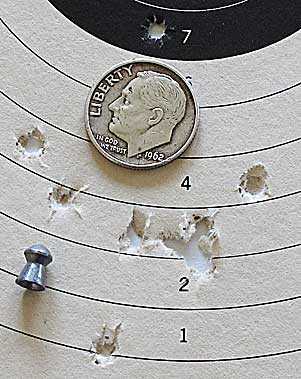
Baracuda Match pellets tightened the group considerably. Except for the lone shot at the top that opened the group to over 2 inches, nine pellets landed in 1.343 inches.
The JSB Exact RS pellet was another goodie. Ten of them went into 1.655 inches. It was very encouraging to see at this point in the testing.
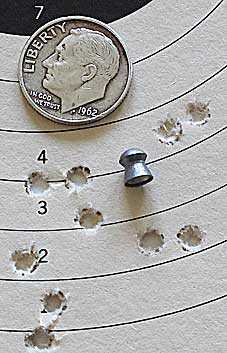
JSB Exact RS pellets made this 1.655-inch group that looks smaller than it measures. After the earlier attempts, this seemed like a breath of fresh air!
Seeing that group inspired me to try something different. I wondered if the pistol could be rested directly on the sandbag and still group. So, I tried two groups that way. The best of them measured 2.267 inches between centers, but within that group were eight shots measuring just 1.052 inches. I tried to better that with a second group, but that was as good as it got.
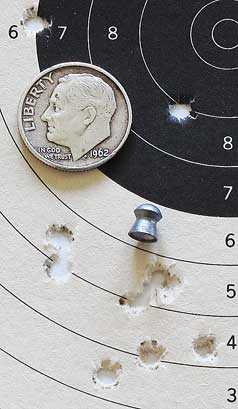
I shot two groups with the pistol rested directly on the sandbag. This was the best one. It looks good, but the two shots that went high are typical of this hold.
And the best
Then I tried RWS Superdomes. Many of you love this domed pellet, and I’ve been working it into more of my testing these days. The Indian seems to like Superdomes a lot. Ten landed in a group that measured 1.383 inches between centers.
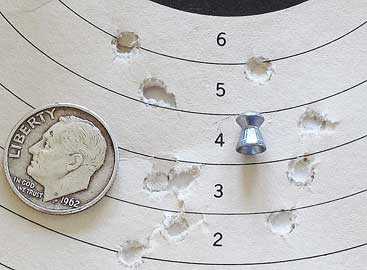
RWS Superdomes turned in the best 10-shot group of this test. The group measures 1.383 inches between centers.
I shot the pistol a lot in this test, mostly because I was getting used to how it handles. As you can see from the groups I’ve shown, it has potential but I can’t say that it’s an accurate pistol. I think this is a gun you need to get used to, and it’s possible I haven’t found the shooting technique for it.
Overall observations
The Cometa Indian is certainly an interesting spring-piston air pistol. It’s well-made, heavy and exceeds its rated power. Yet, it’s also the all-time easy-cocking spring gun champ! Shooting, however, reveals some differences that the buyer needs to know. The pistol is somewhat hard to load, torques in the hand when fired and has a heavier trigger than you might like. However, those are small considerations in light of all the power and the build quality. If you like spring pistols, this is one to consider.

So, if you had a choice of a Tempest or an Indian, which would you choose?
Yes, the Indian has more power but it also has more torque and you do not seem to care for the trigger or the sights. In it’s favor it looks cool and cocks easy. Once you got used to the quirks the accuracy would likely improve. Maybe some industrious after marketeer will come out with some decent rear sights for it. One of the guys in the shop could make a set in an hour or so.
The Tempest is difficult to cock and the pins that are used in the cocking linkage are prone to bending over time. Its handy size and accuracy(in the English version that I own) has made it one of my favorites despite these drawbacks. I have found that the Crosman 2240 has much of the handiness and utility of the Tempest but is rather loud for indoor use. I too am interested in how the Indian would compare to these two. The 2240 already has aftermarket sight upgrades readily available (although I have not modified mine, it would still cost around the same as the Turkish Tempest or the Indian to buy the 2240 and add a steel breech and rear sight if noise is not an issue).
RR,
Having shot both, I would chose the Tempest. However, I hear the Turkish-built Tempest may be different, somehow, from the English-built gun, so I would wait to see if that is true.
B.B.
The Turkish pistol has been given a stronger spring and thus produces a bit more power, but nothing on the level of the Cometa. However, there is a problem as the original Webley gun was quite deliberately not made too powerful to avoid strain on the cocking assembly. The Turkish gun is more difficult to cock, which for anyone who remembers having to cock the old versions will say a lot! I would be interested to see whether the Turkish Tempest, which is otherwise an exact copy, lasts as long as the old Webleys.
Oliver,
That sounds like a test of “How bad can it be?” I’m not sure I want to do that.
B.B.
First I would like to thank everyone that contributed to yesterdays blog, it made for an interesting read for sure! However I couldn’t help but think that the truth is how much you can learn about firearms by shooting air guns especially when you start pushing out to the longest effective range.
As for the Indian, I think the radius going into the rear notch would drive me as crazy as the sloped top line. I think good sight design has more impact on accuracy than fit or trigger quality but it seem as manufactures drop the ball when it comes to sights all the time.
It looks like it would be a good plinker with a little file work on the sights. BB, about how heavy do you think the trigger pull is?
Mike
Mike,
I measured the trigger-pull at 4 pounds, 13 ounces. That was at the end of part 2.
B.B.
Thanks, missed that. Not bad for a plinker.
Mike
Tom did you hear something about the Tokarev TT-33 replica Crosman was supposed to bring out?
They announced it at the shot show and I never heard about it again.
The NP pistol is still on Crosman website but not the TT-33 🙁 so is the TT-33 the same as the NP and they are waiting for the product to arrive or has it been cancelled?
J-F
J-F,
The Crosman model was labeled the C-TT, and it no longer appears on Pyramyd Air’s site, either. Looks like it’s toast.
Edith
I asked to be the new Rangemaster at our shooting range here, as the current one wants to hand it off at the end of the year. Guess what? I got what I asked for!
Pretty excited at the prospect. The range is owned by the city, but managed and maintained by the Sports Club. It has a big sand berm for a backstop, target frames sized to hold 2’x4′ backing panels, a heavy table at 25yards, and two-man shooting benches at 50, 100, and 200 yards. The range is fenced and padlocked, and has a tall flagpole for the range flag.
The range is used by both powder burners and air gunners. I would like to organize some events for next year to encourage participation by young people, and also to introduce adult shooters to air guns.
Maybe hold a tournament or two.
I also want to follow up with the impromptu Field Target course in North Platte, and maybe design a similar course into our shooting range.
While this is a public range (with restrictions), it is also the range used by local law enforcement. Any public tournament would have to be co-ordinated with law enforcement use of the range.
It looks like it will be a busy year for me, as I will still be busy with my Coast Guard Auxiliary duties as well.
I’m open to comments and advice.
Les
I read the comments on the Tempest being hard to cock and I don’t agree. It’s all in the tecnique, here’s how I do it. Unlock the latch,turn the pistol grip upside down in your right hand palm facing you then grasp the barrel with your left hand palm facing you, with thumb on the barrel right behind the front sight. Now simply rotate your elbows outward and you’ve got it. It’s far easier than a P1.
Loren
I just tried this cocking tecnique on my P1 and it works just as well on it, very easy.
Totally agree Loren. People who moan about the Tempest being hard to cock simply do not use the appropriate technique. My technique is analogous to breaking a wishbone – easy! As an aside, the Turkish Centennial version appears to be of equal quality to its English counterpart. I’ve noticed in pictures they don’t appear to be using roll pins in the frame. I’d like to see BB do a review of the Turkish Tempest.
I second a review request on the Turkish Tempest. Didn’t mean to sound like I was moaning about the relative difficulty of cocking the Tempest, I’ve been using the reverse hand technique since the getting my first Premier Mk II back in the late 70’s. Webleys have always been among my favorites because of their handy size and utilitarian design, and I have been considering the similarly sized Indian augment my Webleys, which are getting pretty old (the eldest is a refurbished 1920’s Mk I). The down side to the Webley design has always been the cocking linkage and the pins related to it, which will need repair on occasion (I have replaced several pins over the years), if one shoots often. The Indian sounds like it would be less effort to cock (therefore less stress on these parts) and the cocking arm and related pins are clearly more robust than those on my Webleys. That being said, I have been able to keep my old Webleys going by just replacing an occasional pin while many other air pistols have come and gone. Glad to have these new pistols to consider adding to the cabinet!
Sorry for posting as anonymous, was on the wife’s computer.
Rich,
So noted.
B.B.
Loren et al.,
I think the Turkish-made Tempest may be different from the British-built gun. Oliver says it has a stouter mainspring. This may be a case where one version (that we all know) is pleasant, while the other is not.
B.B.
Les,
My only advice is to make sure you’re covered by the shooting range’s liability policy. Better yet, get a liability umbrella policy as a rider on your homeowners coverage. It’s cheap.
kevin
Right. The Sports Club carries liability insurance for the range, as well as the trap range and other activities.
My own liability insurance would cover people injured on my own property, but it may not cover liability on city property.
We spent a lot of time last night discussing insurance coverage. I’ll check deeper into the liability aspect.
The local 4-H club has a very good air rifle shooting program for school-age kids. It only operates in the winter, shooting inside a heated building at the fairgrounds. It has a competitive shooting team that allows the kids to compete against other local clubs in the Nebraska Panhandle. I would like to devise a way these kids could shoot in the remaining months. A lot of the kids live on farms or ranches where they can shoot year-round, but opportunities are limited for town kids. Also, there are no competitive shooting events for them after the tournament season.
Les
Those look like my 10 shot 5 yard groups. 🙂
B.B., the other day I meant that the act of retrieving the brass and sorting it would take you out of position for your next shot, at least compared to a repeating rifle. But I’ve been thinking about keeping track of your brass, and that is more feasible than I had supposed. You could place each case upright in the same relation to the other cases as the shots are on their target. That way you have an exact record of your shots. That’s if you can handle the searing heat from a just fired casing. I found that out while inspecting my reloaded brass while shooting the Garand. Yeow.
So, a kindred spirit with Zulu! Who’s to say that shooting doesn’t have a certain amount of internal theater involved. Yes, I remember the rank relief tactics. It reminded me of a Marine Corps manual about shooting into designated zones when defending a position. It read: “If you shoot wildly, you will get overrun, but if you maintain fire discipline and fire within your zone, you will see the enemy start to fall.”
I liked the British song at the end.
Men of Harlach, stop your dreaming.
Can’t you see their spear points gleaming
And the warrior pennants waving
To this battlefield!
On the subject of closing the off eye, I notice that Lyudmila Pavlichenko has her left eye completely closed when shooting, and so do a lot of the Russian women snipers. They certainly could shoot a lick, so this can’t be an absolute rule.
Matt61
Matt,
My favorite part of that movie is when the Zulus chant and smack their shields. That sends chills up my spine.
-Chuckj
I like “Zulu” too. Amazing it has survived the PC censors.
Les
Matt,
Closing the left eye can’t be absolute, because I did it for today’s test. Had to, to see the rear sight clearly enough.
B.B.
Turkish Tempest,
I may have to reconsider and test one. It’s expensive for what it is, so it has to perform in its price range.
B.B.
A valid point worth making about the expense. I think my original Tempest (the only one I purchased new in the box) was $89.95 back in 1980 or 81. Granted it was sold in a regular old box not a fitted commemorative case. The Indian at its current price seems to be more in line with what one would expect to pay in today’s dollars for a similar product, adjusting for inflation. At least it seems everything costs a little more than twice what it did back then! Makes the 2240 (or the 1377/1322 series) seem like even more of a value for its price in today’s economy.
BB
Please test a Tempest. My airgun dealer has an old one. If the test proves it to be a shooter I may buy it.
Ton,
I’m looking into it.
B.B.
I have had 3 Webley pistols over the last 10 years the accuracy of them was appalling.
I a Tempest the barrel was out of line so i sent it back for repairs when i got it back i tried all different brands of pellets shooting in my 6 yard indoor range they all shot 2″ to 3″ inches to the left regardless of
left or right wind age adjustment. I have had a Nemesis and a Typhoon both exactly the same useless.
The pride of my collection are a Weihrauch HW45 a Diana P5 Magnum and a Baikal IZH 46 WHICH ARE BRILLIANT I Have also got a Cometa Indian which is a reasonably accurate pistol
PAUL BAKER WINSFORD CHESHIRE
I have a well broken in one, that will challenge my P-1 at 10 meters. I bought it used in 2003. CPLs did 410 fps. 1 inch groups common.